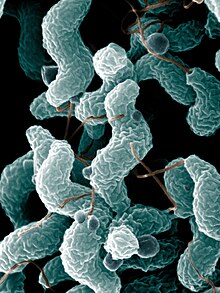Campylobacter
| Campylobacter | |
|---|---|
 |
|
| Campylobacter jejuni | |
| Scientific classification | |
| Domain: | Bacteria |
| Phylum: | Proteobacteria |
| Class: | Epsilonproteobacteria |
| Order: | Campylobacterales |
| Family: | Campylobacteraceae |
| Genus: |
Campylobacter Sebald & Véron, 1963 |
| Species | |
|
C. avium |
|
C. avium
C. butzleri
C. canadensis
C. cinaedi
C. coli
C. concisus
C. corcagiensis
C. cryaerophilus
C. cuniculorum
C. curvus
C. fennelliae
C. fetus
C. gracilis
C. helveticus
C. hominis
C. hyoilei
C. hyointestinalis
C. insulaenigrae
C. jejuni
C. lanienae
C. lari
C. mucosalis
C. mustelae
C. nitrofigilis
C. peloridis
C. pylori
C. rectus
C. showae
C. sputorum
C. subantarcticus
C. upsaliensis
C. ureolyticus
C. volucris
Campylobacter (meaning "curved bacteria") is a genus of Gram-negative bacteria.Campylobacter typically appear comma or s-shaped and motile.
Most Campylobacter species can cause disease and can infect humans and other animals. The bacterium's main reservoir is poultry; humans can contract the disease from eating food contaminated with Campylobacter species. Another source of infection is contact with infected animals, which often carry Campylobacter asymptomatically. At least a dozen species of Campylobacter have been implicated in human disease, with C. jejuni and C. coli being the most common.C. jejuni is now recognized as one of the main causes of bacterial foodborne disease in many developed countries.C. jejuni infection can also spread to the blood in individuals with AIDS, while C. lari is a known cause of recurrent diarrhea in children.C. fetus is a cause of spontaneous abortions in cattle and sheep, as well as an opportunistic pathogen in humans.
...
Wikipedia
